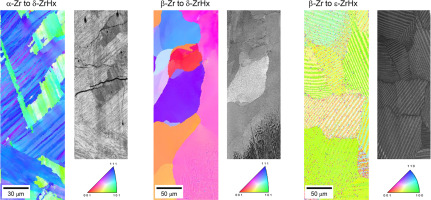Journal of Nuclear Materials ( IF 3.1 ) Pub Date : 2017-12-20 , DOI: 10.1016/j.jnucmat.2017.12.027 Hiroaki Muta , Ryoji Nishikane , Yusuke Ando , Junji Matsunaga , Kan Sakamoto , Stefanus Harjo , Takuro Kawasaki , Yuji Ohishi , Ken Kurosaki , Shinsuke Yamanaka

|
Precipitation of brittle zirconium hydrides deteriorate the fracture toughness of the fuel cladding tubes of light water reactor. Although the hydride embrittlement has been studied extensively, little is known about physical properties of the hydride due to the experimental difficulties. In the present study, to elucidate relationship between mechanical properties and microstructure, two δ-phase zirconium hydrides and one ε-phase zirconium hydride were carefully fabricated considering volume changes at the metal-to-hydride transformation. The δ-hydride that was fabricated from α-zirconium exhibits numerous inner cracks due to the large volume change. Analyses of the neutron diffraction pattern and electron backscatter diffraction (EBSD) data show that the sample displays significant stacking faults in the {111} plane and in the pseudo-layered microstructure. On the other hand, the δ-hydride sample fabricated from β-zirconium at a higher temperature displays equiaxed grains and no cracks. The strong crystal orientation dependence of mechanical properties were confirmed by indentation test and EBSD observation. The δ-hydride hydrogenated from α-zirconium displays a lower Young's modulus than that prepared from β-zirconium. The difference is attributed to stacking faults within the {111} plane, for which the Young's modulus exhibits the highest value in the perpendicular direction. The strong influence of the crystal orientation and dislocation density on the mechanical properties should be considered when evaluating hydride precipitates in nuclear fuel cladding.
中文翻译:

氢化条件对氢化锆组织和力学性能的影响
脆性氢化锆的沉淀降低了轻水堆燃料包壳管的断裂韧性。尽管氢化物脆化已被广泛研究,但由于实验困难,对氢化物的物理性质了解甚少。在本研究中,为阐明机械性能与微观结构之间的关系,考虑到金属-氢化物转变时的体积变化,精心制作了两种δ相氢化锆和一种ε相氢化锆。由α-锆制成的δ-氢化物由于体积变化大而显示出许多内部裂纹。对中子衍射图和电子反向散射衍射(EBSD)数据的分析表明,样品在{111}平面和伪层微结构中显示出明显的堆垛层错。另一方面,在较高温度下由β-锆制成的δ-氢化物样品显示等轴晶粒且无裂纹。通过压痕试验和EBSD观察证实了机械性能的强烈的晶体取向依赖性。从α-锆氢化的δ-氢化物的杨氏模量比从β-锆制备的低。差异归因于{111}平面内的堆垛层错,其杨氏模量在垂直方向上显示出最大值。



























 京公网安备 11010802027423号
京公网安备 11010802027423号